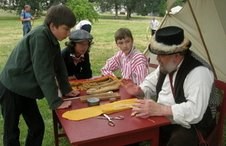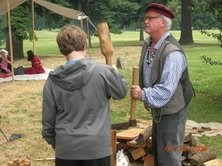
NPS Within the fur trade world of the 19th century, education--either at a school or through an apprenticeship—was crucial for advancement. Even at the frontier outpost of Fort Vancouver, education for your people was highly encouraged. At one time, it was recorded that 60 students were attending school at the fort, 40 of which were boys. In the mornings girls and boys attended school together in the building known as the Owyhee Church, then separated in the afternoons. During the morning session, young men learned to read, to write the ornate copperplate script of the time, and studied subjects such as geography, botany, math, and music. Afterward, they worked in the fields, gardens, or tradeshops, while girls were instructed in handwork as would have been common at a Dame School. Young men learned skills on the job from tradesmen or engagé, the contracted employees of the company. 
NPS The students were the children of Hudson’s Bay Company employees stationed throughout the region, as well as orphans of Native Americans who were sponsored for tuition by Company employees. They came from a variety of cultural backgrounds, often laced a single language for easy communication. Despite this barrier, the Fort Vancouver school flourished for a number of years, until disagreements over religious instruction and the departure of Chief Factor John McLoughlin weakened its support. Eventually the school closed, as students began to board at other area schools that had been established in the meantime. Following this time honored tradition, our volunteer training program for young men was named the Young Engagé School. The curriculum- taught by instructors assisted by several Engagés-includes many of the skills that were included here historically, as well as themes which assist the students in sharing their knowledge with visitors to the site. 
NPS The Young Engagé School Today:
Fort Vancouver National Historic Site Attn: Youth Volunteer Interpretive Training Program 612 East Reserve Street Vancouver, WA 98661
|
Last updated: October 11, 2019
